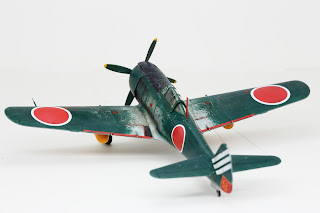Continuing a short season of Japanese Army fighters regular AoJ correspondent Alex has shared these images of his 2021 build of the 1/72 Sword Nakajima Ki-44-II 'Shoki' 'Tojo' kit released in 2011 (and in-box reviewed here). 'Shoki' is always a favourite here but the Sword kit is not seen so often in built model form.


Alex chose one of the kit's subjects, a 40mm armed Ki-44-II Otsu white '20' of Hiko Dai 47 Sentai at Narimasu in late 1944, differing from Sword's instructions by depicting the leading edge IFF strips in red rather than yellow.


The 47th's confusing Chutai identity colour sequence has been discussed here before so we won't go there today. Suffice it to say that Sword identify this particular bird as being from the 1st Chutai. In December 1943 the 2nd Chutai had been detached to Tokorozawa airfield where it had the opportunity to fly and test the Army Flight Test Centre's Focke-Wulf Fw-190 A5 against its Shoki thanks to the auspices of former unit commander and then test pilot at the centre Maj Susumu Jimbo. In October 1944 the 47th was rated by Army Air HQ as the best unit in the 10th Air Division with many skilled pilots. During this period the 10th Air Division commander had instructed that each of the Sentai within his command would be required to form special air-to-air ramming units in flights of three or four aircraft. In the 10th Air Division, these small flights of stripped and unarmed fighters, often garishly painted, became known as Shinten Siekutai or ‘Heaven Shaking Air Superiority Units’. In early 1945 the unit was transferred under direct command of the 6th Air Army and began to re-equip with the Ki-84 Hayate to serve in the bomber escort role against expected enemy carrier attacks. On 19 March 1945 the unit was again transferred, this time to the newly re-formed 30th Fighter Group for the 'Sei-Go' operation as part of the 'Mobile Air Defence Forces' which would take over from 6th Air Army in defending the Kanto region against invasion, being based at Miyakonojo West airfield. The 47th ended the war at Ozuki after transfer to the 12th Air Division in July 1945.
























































